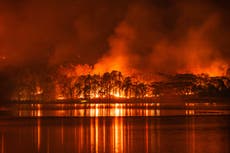Heat more deadly in US than any other extreme weather, data shows
Heat accounted for more deaths in 2021 than floods, hurricanes, tornadoes and cold weather
As the climate crisis increases average temperatures around the world, new data has revealed that extreme heat is an evermore urgent problem, outpacing other weather events in its deadliness.
Floods, hurricanes, tornados and even freezing conditions are all dwarfed by the total number of fatalities that occur each year from extreme heat, according to findings from the US National Weather Service.
The government agency found that 190 people died from heat in 2021, far above the 10-year average of 135. The next deadliest weather event was flooding, which claimed 146 lives in the same year, and 98 on average in the past decade.
Other dangerous weather included rip currents, cold weather and tornadoes, all of which were much more deadly in 2021 than the 10-year average.
Extreme heat events, evident in this summer’s record-breaking highs around the world, are likely to be both more frequent and more severe due to the climate crisis.
And other extreme weather events, like floods, hurricanes and wildfires, are being fuelled by the rising global temperature caused by greenhouse gas emissions largely from burning fossil fuels.
In July, nearly every region in the US was struck by unrelenting heatwaves, placing more than 150 million people under heat warnings and advisories. More than 350 new daily high-temperature records were tracked, according to the National Oceanic and Atmospheric Administration.
Last week, abnormally high temperatures in the Pacific Northwest led to at least 20 potential heat-related deaths.
But that pales in comparison to last year’s “heat dome” event in the Pacific Northwest, which killed over 800 people in the US and Canada. The heatwave, where the normally temperate region saw the mercury reach well above 100 degrees Fahrenheit (38 degrees Celsius), was deemed to be 150 times more likely because of the climate crisis.
Extreme heat can cause serious health issues when the body gets severely dehydrated or loses the ability to cool itself down. In minor cases, heat can lead to fainting or cramps – but in serious cases, extreme heat can cause heat stroke as the body rapidly reaches temperatures above 100F (38C).
Heat stroke can be fatal without emergency medical treatment. Some of the people most vulnerable to heat illness are the elderly, young children, pregnant people and those with underlying health conditions like heart disease.
In addition, heat can affect some communities more than others. Outdoor workers, poorer people and homeless people are all at higher risk for health issues from the heat, notes the World Health Organization (WHO).
A 2021 study found that in the US, poorer neighbourhoods and neighbourhoods with more Black, Hispanic and Asian people were generally hotter than richer and whiter neighbourhoods, which can put additional heat burdens on those communities.
Beyond the blistering heat, climate experts also warn of dangerous increases in air moisture, or humidity.
“There are two drivers of climate change: temperature and humidity,” V “Ram” Ramanathan, a climate scientist at the University of California San Diego’s Scripps Institution of Oceanography and Cornell University, told the Associated Press.
Humidity, combined with the temperature on the thermometer, creates the “apparent temperature”, or what it feels like outside. In addition, high heat and humidity can raise the “wet bulb” temperature – a measure of how much the body is able to cool itself off.
Scientists have warned that wet-bulb temperatures above 95F (35C) are “unsurvivable” for humans who experience it for at least six hours. While instances of wet-bulb temperatures that high are still rare, they are becoming more common around the world, according to Nasa.
Large parts of the US are facing a hotter-than-average August, according to the monthly outlook from the National Weather Service’s Climate Prediction Center.
Blistering temperatures returned to the central US this week, with temperatures hovering around or above 100F (38C) from Texas through South Dakota.
Much of the central US and northeast is under a heat advisory as high temperatures combined with humidity will make it feel above 90F (32C) or 100F through the northeast, southeast and central Plains. Conditions in southwest Iowa could feel up to 113F (45C) on Saturday as heat and humidity push through.
On Thursday, both Boston, Massachusetts and Hartford, Connecticut broke their daily temperatures records as the mercury hit 98F (37C) and 96F (36C), respectively.
Join our commenting forum
Join thought-provoking conversations, follow other Independent readers and see their replies
Comments





Bookmark popover
Removed from bookmarks